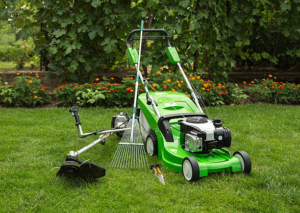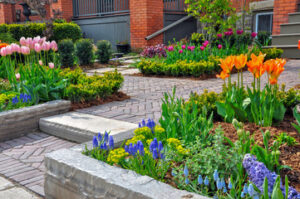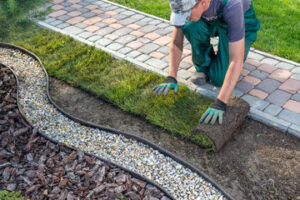Lawn Care Mooresville industry is booming. It’s a huge sector that includes a variety of treatments, such as fungicides, pest control, and fertilization.
Lawns have profound ecological impacts locally and can alter nutrient and hydrologic cycles and general ecosystem structure and function [1]. Yard care has been linked to significant environmental consequences in residential areas.

A lawn is a beautiful addition to any home, but it takes more than just mowing to keep it healthy and vibrant. Lawn care and maintenance services proactively prevent long-term damage by addressing problems such as pest infestations, nutrient deficiencies, or soil imbalances. They use an extensive understanding of grass and soil types to develop a customized care program for each yard. They then implement this plan through a combination of traditional and organic care treatments.
A well-managed lawn requires an adequate amount of water to thrive. An efficient sprinkler system delivers just the right amount of moisture to each blade of grass, keeping it hydrated without overdoing it. This helps reduce common lawn issues like brown spots and overwatering-induced diseases.
Depending on the season, your lawn may need additional watering to combat hot weather or dry conditions. Lawn service professionals know the ideal frequency and duration of irrigation to promote healthy growth while minimizing water waste.
Weed control is another essential component of lawn maintenance. Regular weeding keeps invasive species from overtaking your grass and crowding out vital nutrients. It also prevents weed seeds from spreading in the mowed area, saving you time and money from pulling them out by hand.
Lime applications are important for maintaining proper soil PH, which is critical to the health of your lawn. Lime balances out acidic soils, allowing grasses to absorb and hold onto the nutrients they need for optimal health.
Fall is an excellent time to aerate and overseed your lawn, repairing damages from summer heat and drought. Aeration loosens the soil, allowing new grass to grow and thicken your turf.
A healthy lawn is more than just green; it’s a haven for beneficial insects and birds. Lawn care companies monitor for pests and apply insecticide as needed to protect your landscape. They can also recommend a sustainable approach to outdoor pest control, such as encouraging helpful insects and integrating a comprehensive composting program to provide nutrients to your lawn naturally. Raking leaves and other debris from the yard is also an important part of lawn maintenance. An unmanaged pile of leaves can smother grass, preventing it from photosynthesizing and leaving it vulnerable to pests and disease.
Watering
A healthy lawn requires a well-maintained sprinkler system to deliver the right amount of moisture at the correct time. Overwatering causes fungal disease, while under watering encourages shallow rooting. Overly dry soil forces roots to compete with weeds for nutrients and water, and that can lead to weedy lawns. A lawn care company can make sure your irrigation system is set up to deliver the right amounts of water at the best times, and can help you develop a proper grass watering schedule.
A good lawn care service will also offer preventative fungicide treatments to protect your lawn from diseases like leaf spot and brown patch, as well as pests such as grubs. They may also provide services like aeration, overseeding, dethatching, and soil care to keep your yard looking its best year-round.
In the spring, a lawn should be watered for about 30 minutes each morning and then less frequently as temperatures warm up. In summer, water lawns for up to 90 minutes two to three times a week. This is to prevent the lawn from becoming stressed by hot temperatures. In fall, the lawn should only be watered once or twice a week as it slows down its growth and prepares to slip into dormancy.
If you notice signs of underwatering, try walking across your yard barefoot to feel if the soil is moist to the touch or if it’s dry. If it’s dry, water the lawn more frequently, but less deeply. Also, if the soil has a lot of clay in it, the lawn will require less water because the soil holds on to water for longer periods.
As grass grows, it uses up the nutrients in the soil, and so a lawn needs to be fertilized on a regular basis. A soil test can show you the percentage of sand, silt and clay in your soil, and help determine when to fertilize.
Watering in short cycles – for 10 minutes on, then 10 minutes off – keeps the soil from becoming saturated most of the time and promotes deep rooting. To avoid puddling, top dress your lawn with a thin layer of nutrient-rich compost in the fall, which will hold onto moisture and reduce your watering needs.
Fertilizing
Lawn fertilizing keeps grass healthy and strong, preventing weed growth. A well-fed lawn also has a stronger root system that can withstand heat, cold, drought, mowing and foot traffic. A healthy lawn helps to limit erosion, cool the environment, and control allergens. Lawns that are regularly fertilized have a more attractive appearance, too.
Fertilizers replenish nutrients lost from lawn mowing, foot traffic, pet urine and a host of other stresses that damage turf grass. Grass plants use the three primary nutrients for growth: nitrogen (N), phosphorus (P) and potassium (K). While nutrient-rich clippings return some nitrogen to the soil, this can be insufficient over time. A lawn that isn’t properly fertilized will become thin and weak, providing a hospitable environment for weeds and insects.
It’s important to apply fertilizers according to a schedule that is specific for your region and the type of grass you have. For example, a spring fertilizer should be higher in nitrogen to help your lawn recover from winter and tackle the oncoming warm weather. A summer fertilizer should contain a balance of N, P, and K to promote a healthy green color and help your lawn handle the hotter temperatures. A fall fertilizer is usually lower in N but should contain high amounts of phosphorous and potassium to prepare your lawn for the cold of winter.
When you fertilize, be sure to follow all label instructions and to avoid over-fertilizing. Over-fertilizing can damage your lawn by causing it to burn or becoming too dense, as well as contaminating water sources. Rainwater can wash excess fertilizer into lakes, rivers and ponds where it becomes toxic to aquatic life. The EPA recommends staying about 6 to 8 feet away from bodies of water when applying fertilizer.
When choosing a lawn fertilizer, choose a slow-release synthetic or organic one. The latter is made from plant and animal sources, including dried blood, fish emulsion and manure. These types of fertilizers require microorganisms to break them down in the soil before they’re available to grass plants, so they’re more expensive than their synthetic counterparts.
Weed Control
Weeds grow quickly, crowding out grass and competing for water and nutrients. They can also be unsightly and detract from the beauty of your lawn. While a few weeds are inevitable, you can keep them in check by following proper lawn care practices.
Weed control measures must be based on an understanding of the type of weed and its growing conditions. Then, you can determine whether or not chemical control is needed and what type of herbicide should be used. This will help you avoid serious injury to your lawn.
Herbicides can be used on either annual grassy weeds, like crabgrass and dandelions, or broadleaf weeds, such as dandelions and plantains. These products are sold as granular and liquid products and often include a fertilizer mixed in. These types of products are commonly called “weed and feed” mixes. They will be more effective on annual grass weeds than a preemergence herbicide, but may have limited activity on certain broadleaf weeds.
For annual grassy weeds, a preemergence herbicide can be applied in the spring so that they are stopped before they germinate. This will prevent them from getting out of hand during the summer. Annual weeds can also be controlled by mowing at the correct height, usually one-third of the recommended grass mowing height.
Perennial grassy weeds, such as quackgrass and creeping bentgrass, are more challenging to eradicate because they return year after year. They will need to be pulled by hand or sprayed with a nonselective herbicide such as glyphosate.
It is always best to start with good cultural controls and try to avoid the use of chemicals unless absolutely necessary. However, if your lawn is not thriving and the weeds are out of control, call in a pro. A weed removal specialist will be able to identify the specific weeds in your lawn and recommend a weed control plan for you. They can also offer alternatives to chemical applications if that is what you prefer. They can also apply lawn treatments that will prevent weeds from sprouting in the first place.

